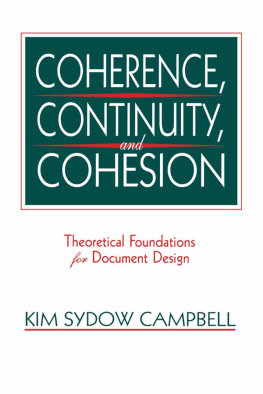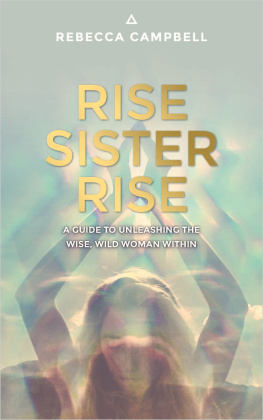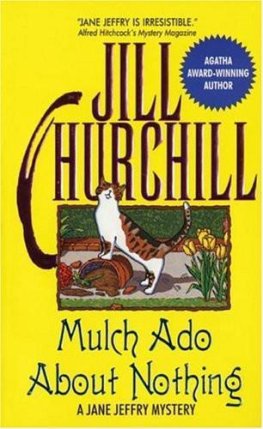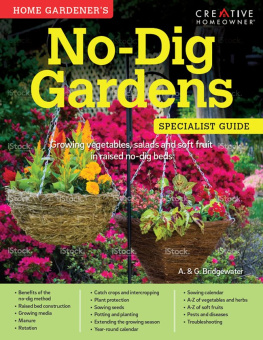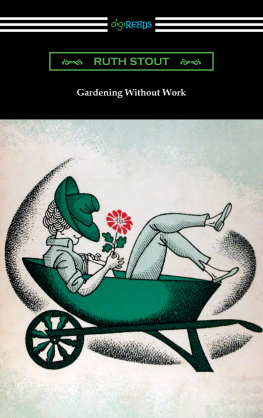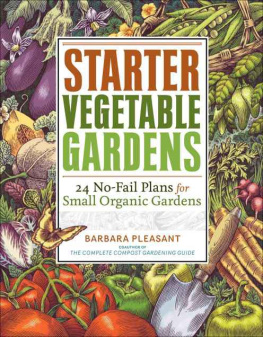Mulch It!
A Practical Guide to Using Mulch in the Garden and Landscape
STU CAMPBELL

The mission of Storey Publishing is to serve our customers by publishing practical information that encourages personal independence in harmony with the environment.
Revised and updated by Charlotte Kidd
Edited by Gwen W. Steege and Larry Shea
Cover design by Leslie Constantino
Text design by Susan Bernier
Text production by Deborah Daly and Jennifer Jepson Smith
Cover photos by Giles Prett
Cover illustrations by Artville
Illustrations by Alison Kolesar
Indexed by Peggy Holloway
2001 by Storey Publishing, LLC. Previously published under the title The Mulch Book, 1991 by Storey Publishing, LLC. All of the information in the previous edition was reviewed and revised for this new text.
All rights reserved. No part of this book may be reproduced without written permission from the publisher, except by a reviewer who may quote brief passages or reproduce illustrations in a review with appropriate credits; nor may any part of this book be reproduced, stored in a retrieval system, or transmitted in any form or by any means electronic, mechanical, photocopying, recording, or other without written permission from the publisher.
The information in this book is true and complete to the best of our knowledge. All recommendations are made without guarantee on the part of the author or Storey Publishing. The author and publisher disclaim any liability in connection with the use of this information. For additional information, please contact Storey Publishing, 210 MASS MoCA Way, North Adams, MA 01247.
Storey books are available for special premium and promotional uses and for customized editions. For further information, please call 1-800-793-9396.
Printed in the United States by Versa Press
10 9 8 7 6 5 4
Library of Congress Cataloging-in-Publication Data
Campbell, Stu.
Mulch it!: a practical guide to using mulch in the garden and
landscape/Stu Campbell.
p. cm.
ISBN 978-1-58017-316-2 (alk. paper)
1. Mulching. I. Title.
S661.5 .C353 2001
635.04dc21
00-063484
contents
PART I
THE WHY AND WHATS OF MULCHING
1
MORE REASONS THAN EVER TO MULCH
Rich looking, neat as a pin, weed free, and glowing with health does that sound like the yard or garden of your dreams? It can easily be a reality if you use mulch. Once thought of primarily for vegetable gardens, mulch has come a long way. Its now recognized as an essential ingredient for more beautiful and easier-to-maintain flower beds and landscape plantings of all kinds. And in addition to beautifying your property, mulch has many important environmental benefits as well, one of the most important of which is water conservation.
Our water supply is finite and often unevenly distributed. Some gardeners may experience water shortages and brush fires, while others are building levees and raised beds. Although mulches may not do much to control excess moisture, they are essential in the battle against water loss. They are so important, in fact, that California enacted a bill requiring the use of mulches: the Xeriscape Act of 1989.
Xeriscaping is a garden design principle whose aim is to reduce the amount of water used on landscapes. While the idea of conserving water in the garden has been around for some time, the xeriscape concept was refined by the Denver Water Department in 1981, after a particularly dry summer. The department developed what have become the seven basic principles of xeriscaping: proper planning and design, limited use of turf areas, use of efficient irrigation systems, soil improvements, mulching, use of plants that demand less water, and appropriate maintenance (such as weeding and fertilizing). This concept quickly spread to Florida, Texas, Arizona, and California, where droughts are a fact of life. The National Xeriscaping Council, Inc., has been established in Austin, Texas, to coordinate and promote the xeriscaping movement. After all that, who would need to be convinced to use mulches?
It seems, though, that mulching does require more justification for some. For one thing, mulch doesnt even sound very nice, which may be one strike against it to begin with. In its earliest Middle English sense, the word mulsh was an adjective that meant, according to Mr. Webster, soft or yielding. Thats not so bad. But by the time our language had evolved into what is now called Early Modern English, centuries later, the s in mulsh had become a c, the adjective had become a noun, the word itself had come to mean rotten hay, and something pleasant was lost in the evolution.
Now this is to suggest neither that rotten hay is necessarily undesirable nor that rotten hay is the only kind of mulch there is. There are many, many kinds of materials that can be used for mulching, as we shall see. The mulch materials you choose for your vegetable garden can be practical, but not necessarily beautiful. On the other hand, youll find dozens of choices for mulching around your landscape plantings and flower beds where the mulch itself can be an important feature of the overall design. Whatever the choice, to the knowledgeable gardener, mulch can be the most beautiful stuff in the world.

A neatly mulched garden can bring many rewards.
A LIVELY DEBATE
Youll soon learn that mulching needs justification among serious and experienced gardeners, too. It is awfully hard to imagine at first glance that a subject like mulching could be very controversial. I mean, either you like to mulch your garden or you dont, right? Not so. Highly regarded gardening authorities like Ruth Stout, known to many gardeners as the complete mulcher, and Leonard Wickenden, a prominent biochemist and thoroughly experienced organic gardener, sparked a mulching debate that has carried on in gardening literature for years. Some people dont know with whom to side, so they dont bother to mulch at all. Well have a look at each of their points of view a little later on.
Some vegetable gardeners object to mulching for purely aesthetic reasons. They prefer the traditional look of arrow-straight rows and bare, immaculately cultivated earth. There still are plenty of these model gardens around, and that sort of thing is fine if you have lots of time and patience, plenty of water, and maybe a few slave laborers who can help you maintain this kind of elegance. Most of us do not. Lets face it: except for the very affluent, the days of the full-time hired gardener are gone forever. Besides, mulch does not have to be unattractive, as we shall also see.
Because my garden is in a northern section of the United States, I know that what works well for me may not work well for you in your garden. You also should remember that there is no one right way and no one wrong way to mulch. There are good ways, and there are not-so-good ways. This book offers suggestions about some ways to mulch your gardens to make them happier, healthier, and more rewarding. I will also try to make you aware of certain dangers and pitfalls, but I will never say, This is the way. That is for you to decide.
2
HERES WHY: The Benefits of Mulching


